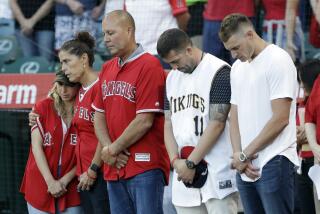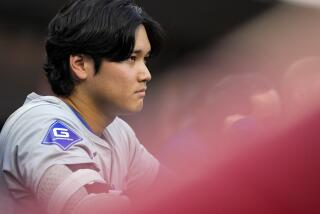Drug Dealer Names 13 Players as Cocaine Users
- Share via
A convicted drug dealer has identified 13 American League players, including four Kansas City Royals who have been imprisoned, as cocaine users, according to a published report.
Mark Liebl, who is serving a six-year sentence in the Fort Worth Correctional Institute after pleading guilty to charges of conspiring to distribute cocaine, told The New York Times that orders for the drug frequently were placed from Royals Stadium and delivered there, the newspaper reported today.
Liebl claimed he used cocaine with three members of the 1982 Boston Red Sox, two players with the 1982 Oakland A’s, two with the 1982 Chicago White Sox, five Royals and one unnamed member of the Minnesota Twins.
Liebl said he snorted cocaine with Dennis Eckersley, Chuck Rainey and Mike Torrez, all pitchers for Boston at the time; Chicago’s Ron LeFlore and Steve Trout; Tom Underwood and Mike Norris of the A’s, plus Kansas City’s U.L. Washington and four Royals who were subsequently jailed for cocaine violations--Willie Aikens, Willie Wilson, Vida Blue and Jerry Martin.
Either directly or through their agents, Eckersley, Rainey, Torrez, LeFlore, Trout and Underwood disputed Liebl’s contention. Washington and Norris refused comment.
“It’s all over baseball,” said Liebl, who was interviewed in prison by former Commissioner Bowie Kuhn.
“Oddly enough, Liebl is a real baseball fan,” Kuhn said. “He wanted to make the players happy, so he supplied them with drugs.”
Liebl said he named names for baseball officials so that the players would be offered help and not punished, the newspaper said. Kuhn said a number of the players named in the interview subsequently underwent drug rehabilitation.
Liebl said his relationship with Blue included some cocaine transactions of such quantity that he knew Blue wasn’t the only one getting some of it.
“Vida was telling me other guys on the team were snorting,” Liebl said.
Liebl accompanied the Royals on several road trips, during which he said he used cocaine with Blue, Wilson and Martin. Later, he said, Aikens and Washington joined him in using the drug.
Liebl said he became upset at a party in Blue’s apartment when a teen-age batboy was allowed to use cocaine.
Liebl also threw cocaine parties, according to the newspaper. Any cocaine used in his house was free; anything taken from the house had to be purchased, usually at $80 per gram.
Players named in court as having been involved with drugs should be asked to undergo testing by their teams, the head of the committee that reviews suspected drug abuse in major league baseball said Tuesday in Washington.
Dr. Donald Ottenberg, chairman of baseball’s three-member Joint Review Committee, made his comments during a panel discussion here on “The Drug Problem as Seen in Today’s Professional Athlete” at the HealthCare Expo ’85.
“In my opinion, any information of a new player named in a court of law is sufficient reason for management to ask for testing,” Ottenberg said.
Under baseball’s agreement with the players’ association, a team may not require unannounced urine tests of its players. It may, however, ask for tests of players suspected of drug dependency.
On Monday, Dale Shiffman, one of seven men charged with selling drugs to players, pleaded guilty in federal court in Pittsburgh to 20 drug trafficking charges. An assistant U.S. prosecutor said that had the case gone to trial, Pirate pitcher Rod Scurry was prepared to testify that he had bought drugs from Shiffman.
In subsequent trials in Pittsburgh, as many as eight players, all of whom have been promised immunity from prosecution, are expected to testify.
“There is a drug problem in baseball but we do not know the extent of it,” Ottenberg said, adding: “There is no evidence whatsoever that it is a runaway problem. In fact, there is some evidence it is waning.
“We have not had a new case of substantive use in two years. What we have had is relapses,” Ottenberg said.
The New York Times, meanwhile, in the second of a series of articles on cocaine abuse by major leaguers, reported in Tuesday’s editions that John McHale, president of the Montreal Expos, blamed cocaine use for his team’s failure to win its division championship in 1982, when the team generally was considered to be the best in the National League.
Tim Raines, a sensation as a rookie in 1981, was the only one of the ’82 Expos to be publicly identified as a cocaine user and voluntarily entered a treatment center after the season.
“Now that I look back, I probably was the only one that did undergo treatment, but I wasn’t the only one that needed to,” Raines is quoted as saying.
Raines said that he became involved with cocaine through older teammates and became a heavy user, using cocaine virtually every day.
“I had it in little gram bottles that I kept in my pocket,” Raines said. “Actually, a lot of times I would put it in my batting glove and then in my pocket. I was trying to find ways of not getting caught.”
When he slid into a base, Raines said, he protected his investment. “Usually, when I carried it in my pocket, I’d go in head first,” he said.
In 1982, Raines’ batting average dropped 27 points to .277. In 1981, he stole once out of every 1.97 times he reached base; in 1982, he stole once out of every 3.26 times.
“I struck out a lot more,” Raines said. “My vision was lessened. A lot of times I’d go up to the plate and the ball was right down the middle and I’d jump back, thinking it was at my head. The umpire would call it a strike and I’d start arguing. He’d say, ‘That ball was right down the middle.’ When you’re on drugs, you don’t feel you’re doing anything wrong.”
More to Read
Go beyond the scoreboard
Get the latest on L.A.'s teams in the daily Sports Report newsletter.
You may occasionally receive promotional content from the Los Angeles Times.









